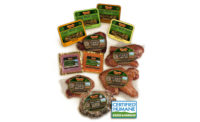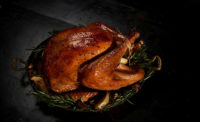There are regional favorites or specialties throughout the barbeque world. Brisket is big in Texas. Kansas City has its ribs. The Carolinas and Georgia are pork-centric. But poultry is a staple of barbeque restaurant menus, too, even if it doesn’t get talked about as much. That is something that Ray Lampe, aka Dr. BBQ, hopes to change.
“It’s hard to find a BBQ restaurant that doesn’t serve turkey; they just don’t talk about it much, but they serve it,” he says. “At my restaurant, I can tell you it’s a big seller. But everyone wants to talk about the brisket and the ribs and pork shoulder.”
Earlier this year, Lampe was named a Spokeschef for the National Turkey Federation’s “Turkey Smoke” campaign. The goal of the movement is to popularize turkey in BBQ competitions and get chefs and consumers to start thinking outside the box when it comes to turkey preparation.
For Lampe, the association with turkey is a natural one. He has been extolling the virtues of turkey for years. His first BBQ trophy, won in 1991, was for turkey.
“I have a long history of cooking turkey on the grill, and I’m a huge fan of it, so it’s a great fit for me. I’ve also written nine cookbooks, so the challenge of creating inspiration to cook other cuts of turkey or cook turkey more often on the grill is exciting for me,” he says. “I like opportunities where we can move the needle on something, and this one is a natural.”
Part of the problem, he says, is that people who buy turkey in a store think about white meat or whole turkey, and not much in between.
“They don’t think about more interesting cuts of turkey. I see it as a great opportunity,” says Lampe, adding that turkey processors should be touting new cuts and products like boneless skinless turkey thighs.
Lampe has developed several recipes for the NTF website, including a turkey scotch egg and a turkey tamale pie. He’s also done interesting things with a whole turkey, such as smoking and serving it up like a whole hog that people can pull apart.
Lampe says that getting people to accept 165 degrees as a good temperature for turkey will help in gaining more acceptance. Part of consumer hesitancy for turkey is that too many people remember Thanksgiving dinners of their childhood being dry and tasteless because they were cooked to 180 degrees.
“The biggest thing that has happened in my experience over the years has been learning to cook things properly. Brisket can be a miserable thing to eat if you don’t cook it right,” Lampe says. “I call a lot of these new-wave BBQ guys technicians because they spend so much on thermometers and the science of how things work. That’s really been our friend with a lot of these harder-to-cook things. I think that what will be the solution for turkey.”










